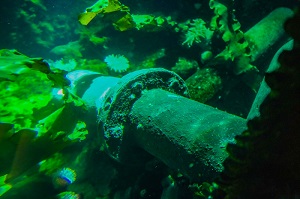'Outside Activity' Likely Damaged Gas Pipeline, Telecoms Cable, Finland Says
(Reuters) — A subsea gas pipeline and a telecommunications cable connecting Finland and Estonia under the Baltic Sea have been damaged in what may have been a deliberate act, the Finnish government said on Tuesday.
NATO Secretary General Jens Stoltenberg said NATO was sharing its information over the damage and stands ready to support the allies concerned.
The Balticconnector gas pipeline was shut early on Sunday on concerns that gas was leaking from a hole in the 77-km (48 miles) pipeline. Finnish operator Gasgrid said it could take months or more to repair.
"It is likely that damage to both the gas pipeline and the communication cable is the result of outside activity. The cause of the damage is not yet clear, the investigation continues in cooperation between Finland and Estonia," Finnish President Sauli Niinisto said in a statement on Tuesday.
Finnish Prime Minister Petteri Orpo will hold a press conference at 1430 GMT, his office said on Tuesday.
"The fall in pipeline pressure was quite fast, which would indicate it's not a minor breach. But the cause of it remains unclear," said a Baltic energy official with knowledge of the situation, who spoke to Reuters on condition of anonymity.
The pipeline between Inkoo in Finland and Paldiski in Estonia crosses the Gulf of Finland, an arm of the Baltic Sea that stretches eastwards into Russian waters and ends at the port of St Petersburg.
No potential causes for the outage could be ruled out for the time being, including sabotage, a spokesperson for Estonian gas system operator Elering said on Monday.
In 2022, the larger Nord Stream gas pipelines which cross the Baltic Sea between Russia and Germany were damaged by explosions that authorities have said were deliberate acts of sabotage.
The Balticconnector pipeline opened in December 2019 to help integrate gas markets in the region, giving Finland and the Baltic nations of Estonia, Latvia and Lithuania more flexibility of supply.
Elering and Gasgrid have both said they did not anticipate shortages of gas even if the pipeline were to remain inoperable during winter.
Finland last year leased a floating storage and regasification unit (FSRU) to receive liquefied natural gas (LNG), replacing supplies from Russia which were cut in the wake of Moscow's invasion of Ukraine.
Much of Finland's LNG imports come from the United States, LSEG data shows.
Situated at Inkoo, the Exemplar FSRU vessel has supplied gas to Estonia via the Balticconnector.
"(It's) not a big deal for Estonia and Latvia because a lot of their gas is stored in Latvian storage, but Finns will not be able to get their gas from Latvian storage," said a source with direct knowledge of Baltic gas supplies.
Finland has a second LNG import terminal in Hamina, and "the continuity of gas supply is secured in the coming winter season," national operator Gasgrid said in a statement.
Finnish telecommunications operator Elisa separately said the damaged cable was primarily used for backup purposes and that the company's services had not been disrupted.
Nordic and Baltic neighbors also offered assistance.
"Sweden stands with our Nordic-Baltic colleagues and are ready to offer any help regarding the damage to undersea infrastructure between Finland and Estonia," Swedish Foreign Minister Tobias Billstrom said in a post on X, formerly known as Twitter.
Latvia's President Edgard Rinkevics expressed "our solidarity and support" to Finland and Estonia.
Related News
Related News

- Enbridge Plans 86-Mile Pipeline Expansion, Bringing 850 Workers to Northern B.C.
- Intensity, Rainbow Energy to Build 344-Mile Gas Pipeline Across North Dakota
- U.S. Moves to Block Enterprise Products’ Exports to China Over Security Risk
- Strike Pioneers First-of-Its-Kind Pipe-in-Pipe Installation on Gulf Coast with Enbridge
- 208-Mile Mississippi-to-Alabama Gas Pipeline Moves Into FERC Review
- U.S. Pipeline Expansion to Add 99 Bcf/d, Mostly for LNG Export, Report Finds
- A Systematic Approach To Ensuring Pipeline Integrity
- 275-Mile Texas-to-Oklahoma Gas Pipeline Enters Open Season
- LNG Canada Start-Up Fails to Lift Gas Prices Amid Supply Glut
- Strike Pioneers First-of-Its-Kind Pipe-in-Pipe Installation on Gulf Coast with Enbridge





Comments